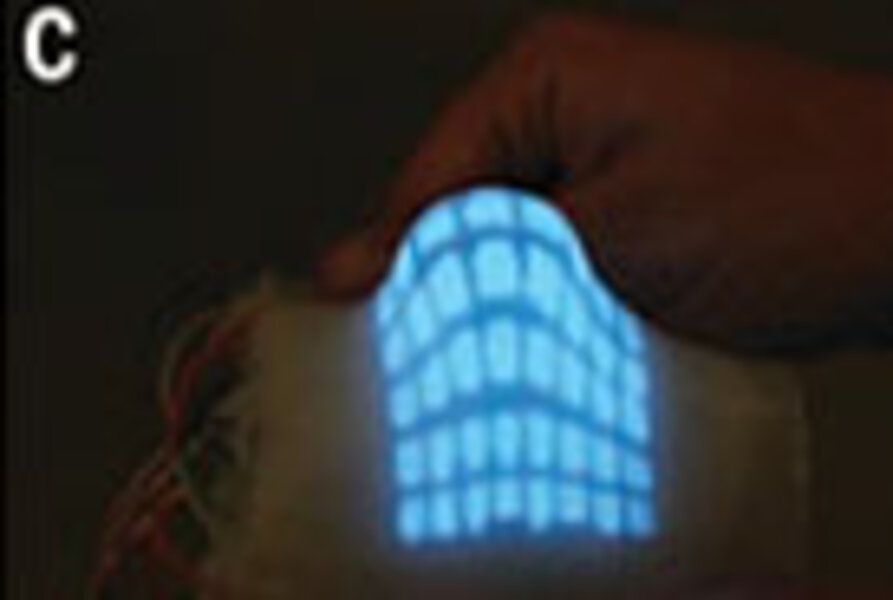This new robot skin can glow, stretch – and walk
Loading...
Most electronics can't handle pressure, and even wearable tech does not respond well when stretched to 500 percent of its original size.
A new, cell phone-sized artificial skin developed at Cornell University, however, not only stretches under pressure, but also glows all the brighter.
"It’s actually much, much, much more stretchable than human skin or octopus skin," says Chris Larson, a doctoral candidate and researcher in Cornell's Organic Robotics Lab. "In terms of texture, it’s actually more like a rubber band or a balloon."
Some are comparing the new technology to "octopus skin," though Larson says he has more experience with the cutting-edge technology than with the cephalopod. He and his colleagues describe their findings Thursday in the journal Science.
The octopus comparison comes from an octopus beak, with its potential to move and stretch. The team was inspired by biology to create a balloon that bends when pressurized. The team placed an unyielding carbon fiber on the bottom and left the top free to respond to the pressure from both within and without.
"The researchers created a three-chamber robot from the material, with the newly developed 'skin' layers on top, and inflatable layers below that allow movement," according to a release from the American Association for the Advancement of Science. "As the chambers expand linearly, the robot moves forward with a worm-like wiggle."
Such electronic skin is not a completely new invention. These skins can generally sense pressure, meaning they send a signal when touched to a computer, and it interprets and responds accordingly. They have not, however, been able to accept embedded electronics, which generally break when molded or stretched. The team's innovative solution to this problem is a hyperelastic, light-emitting capacitor (HLEC).
"Our system has that same capability [to sense pressure] but it also can emit light," Larson says. “So the type of skin that we’ve been able to develop is actually more similar to that of an octopus.”
A robot with this artificial skin moves with what researchers in the study described as an "undulating gait." And as it moves, it can glow even more brightly. Larson compares it to a sheet of rubber – when pulled in one direction, it compresses perpendicular to the line upon which it is stretched.
The glow results from the skin's embedded electric field, and it can glow in a variety of colors, depending on which of a series of metal powders are chosen for the mix. The technology is not unlike that of a car dashboard, or the exit signs in buildings, and the team sees potential for the skin in industry, where robots and humans are already working side by side.
"We can take these pixels that change color and put them on these robots, and now we have the ability to change their color," said Rob Shepherd, assistant professor of mechanical and aerospace engineering at Cornell, in a press release. "Why is that important? For one thing, when robots become more and more a part of our lives, the ability for them to have emotional connection with us will be important. So to be able to change their color in response to mood or the tone of the room we believe is going to be important for human-robot interactions."
It could also have short-term applications, as the team is already talking with several American automobile companies about replacing touch-screen interfaces, which require a driver to look away from the road, with a potentially light-emitting "button" that responds to human touch in both an electronic and tactile manner.
Larson says he also sees the potential for wearable tech that sits elegantly on the skin – and stretches under pressure.






